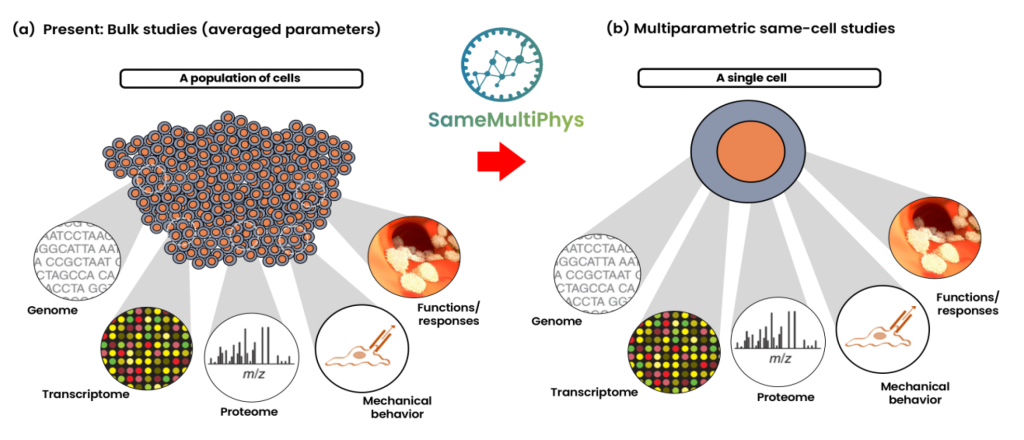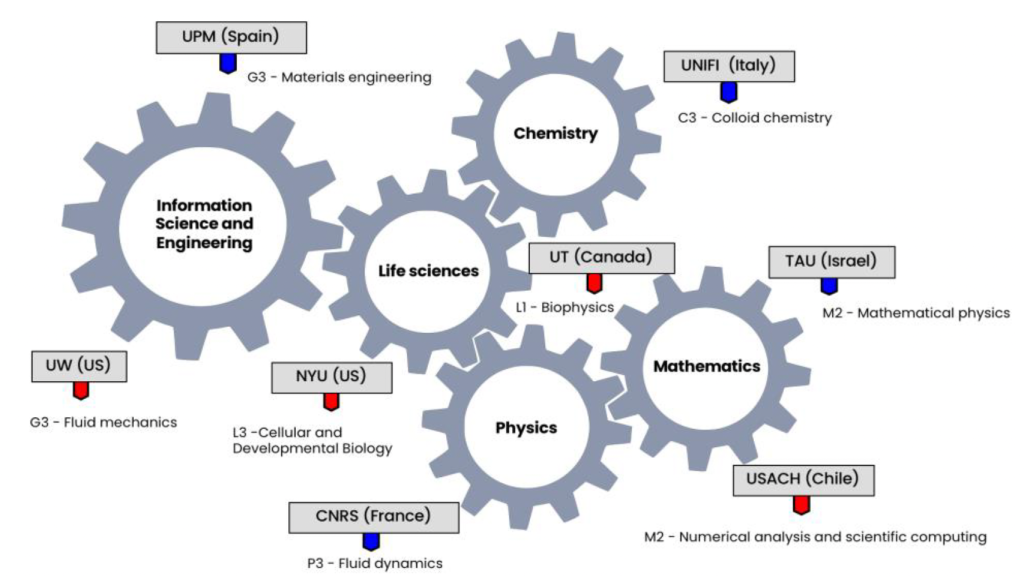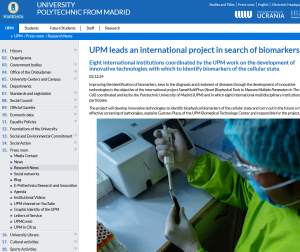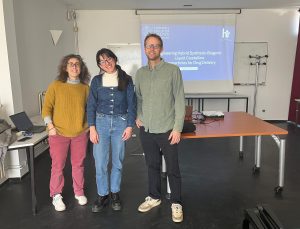
Novel Biophysical Tools to Measure Multiple Parameters In The Same Cell
(HORIZON-MSCA-2022-SE-01-01. Grant agreement ID: 101131612)
_______________
The Group of Mechanobiology of the Center for Biomedical Technology coordinates the project SameMultiPhys, founded under Marie Skłodowska-Curie Actions (MSCA) of the European Commission (Novel Biophysical Tools to Measure Multiple Parameters In The Same Cell, Topic: HORIZON-MSCA-2022-SE-01-01. Grant agreement ID: 101131612, duration: 2023-2027. DOI: 10.3030/101131612).
You can find more details about the project on the CORDIS web and follow the project’s Linkedin and X profiles for updates.
_______________
Summary
Physical forces and mechanical properties influence the behaviour, function, and development of cells and organisms. Biophysical biomarkers, including the ability of a cell to deform under pressure, highlight vital changes in disease progression and can be used for early disease detection. Despite current microfluidic techniques allowing high-throughput measurements, they fall short in providing comprehensive, multi-feature data from the same cell, hindering insights in mixed cell populations. Funded by the Marie Skłodowska-Curie Actions programme, the SameMultiPhys project aims to create custom microfluidic systems capable of measuring multiple cellular features on the same cell. The work is expected to deepen the understanding of cell mechanobiology, advancing biomarker identification for improved diagnostics.
Objectives
Biophysical biomarkers of cell state can reveal physiologically relevant changes that occur during disease progression. For example, cell deformability, cytoskeletal and nuclear organization, and macromolecular crowding are biophysical parameters implicated in migration and growth, which are essential processes for cellular functions. As biophysical parameters reflect physio-pathological cell states, they have the potential to be used as biomarkers for early diagnostics and clinical treatments in medicine. Current techniques based on microfluidics can be used to perform biophysical measurements in a high-throughput manner. However, these systems are not able to provide multiparameter, biophysical and same-cell measurements, making it difficult to find insightful relationships in heterogenous cellular mixtures.
SameMultiPhys will develop and produce customized microfluidic systems to measure multiple features in the same cells and evaluate their potential applications as biophysical biomarkers. These new technologies will allow us to study multiscale biological questions of immune T cells from an interdisciplinary perspective and other cell lines. This project aims to facilitate the transfer of knowledge and resources between institutions with expertise in microengineering, materials science, chemistry, mathematics, biology, and biophysics to promote collaboration between researchers, and to develop innovative microfluidic technologies for mechanobiology. The project will involve state-of-the-art microfabrication techniques, deep-learning analysis of images, and computational modelling to develop and validate the technologies developed. The ultimate goal of this project is to gain a deeper understanding of the mechanobiology of cells, enabling progress toward more effective identification of biomarkers.

Partners
The consortium brings together 8 different partner organizations from 4 EU Member States or Horizon Europe Associated Countries (Spain, France, Italy, and Israel) and 3 non-associated Countries (Canada, Chile, and United States). This geographic spread will ensure European-wide representativeness and good coverage of interdisciplinary research groups in academic institutions.

Beneficiaries
UNIVERSIDAD POLITÉCNICA DE MADRID (SPAIN) – COORDINATOR
Coordinator and group leader
Gustavo R. Plaza
Members
Blanca González Bermúdez
Diego Arturo Ñaña
CENTRE NATIONAL DE LA RECHERCHE SCIENTIFIQUE (FRANCE)
Group leader
Pierre Joseph (IP)
Members
Pierre Lapeze
UNIVERSITA DEGLI STUDI DI FIRENZE (ITALY)
Group leader
Costanza Montis (IP)
TEL AVIV UNIVERSITY (ISRAEL)
Group leader
Yael Roichman (IP)
Members
Ron Vatash
Associated partners
NEW YORK UNIVERSITY (UNITED STATES)
Group leader
Liam Holt
THE GOVERNING COUNCIL OF THE UNIVERSITY OF TORONTO (CANADA)
Group leader
Craig Simmons
UNIVERSIDAD DE SANTIAGO DE CHILE (CHILE)
Group leader
Claudio García
Members
Aldo Abarca
Enzo Brito
UNIVERSITY OF WASHINGTON (UNITED STATES)
Group leader
Juan Carlos Del Alamo
Interdisciplinarity
The essence of the SameMultiPhys research methodology is interdisciplinary and leverage on partner institutions with a strong track record in the areas of knowledge involved in the field of mechanobiology, including materials engineering, fluid mechanics, cellular and developmental biology, biophysics, colloid chemistry, mathematical physics, numerical analysis, and scientific computing. The consortium brings together knowhow in complementary fields, through academic research and previous collaborations through short research stays and/or collaborative projects. The project structure was designed to ensure cross-collaboration and exploit the wide academic expertise available through the Consortium. The partner organizations also bring to the project their extensive networks in healthcare, which will be fundamental in the reality testing of the novel prototypes proposed and in the identification of their real-world enablers and barriers.

Dissemination
EVENTS
- 02/09/2024 at 10:00 (ECT). Blanca González Bermúdez (UPM) and Pierre Joseph “SameMuliPhys Project: Multiple Biophysical Measurement on Single Cells” at LAAS (CNRS, Toulouse). Seminar about project updates and progress’s updates to the MILE team, directed by Pierre Joseph, during the first secondment of the project at LAAS-CNRS of Toulouse.
- 02/12/2024 at 10:30 (ECT). Iñaki Fraga (UPM). “Biophysical Characterization of Electrical and Mechanical Parameters in the Same Cell Using Microfluidics.” at the Center for Biomedical Technology (UPM, Madrid). Seminar about the Bachelor’s thesis of an undergraduate student, who will be supervised by Gustavo R. Plaza and Blanca González (UPM) during the academic year 2024/25. The student will be contributing to the progress of Work Package 2.

- 02/12/2024. Press realease published on the Universidad Politécnica de Madrid website, describing the objectives of the project and its progress. Title “UPM coordinates an international proyect aiming to identify biomarkers” (Original Title in Spanish “La UPM lidera un proyecto internacional en busca de biomarcadores”)

- 06/02/2025 at 14:00 (ECT). Valentina Pacciani (Università Degli Study di Firenze). “Engineering Hybrid Synthetic-Biogenic Liquid Crystalline Nanoparticles for Drug Delivery” at the Université de Toulouse (Toulouse, France). Seminar about the PhD progress of a seconded researcher at LAAS-CNRS, supervised by Debora Berti and Costanza Montis. Valentina ntributing to the progress of Work Package 3.

PUBLICATIONS

